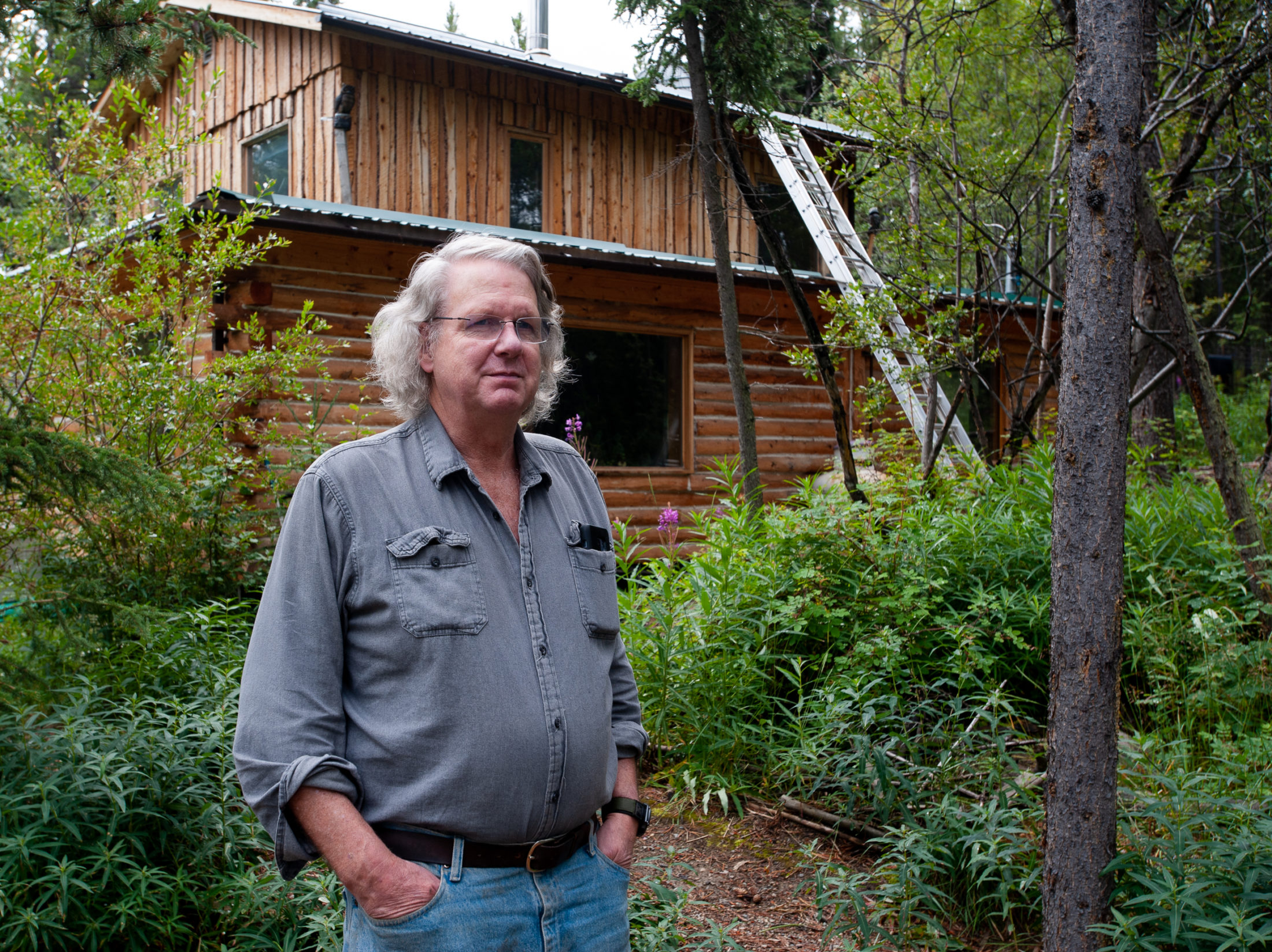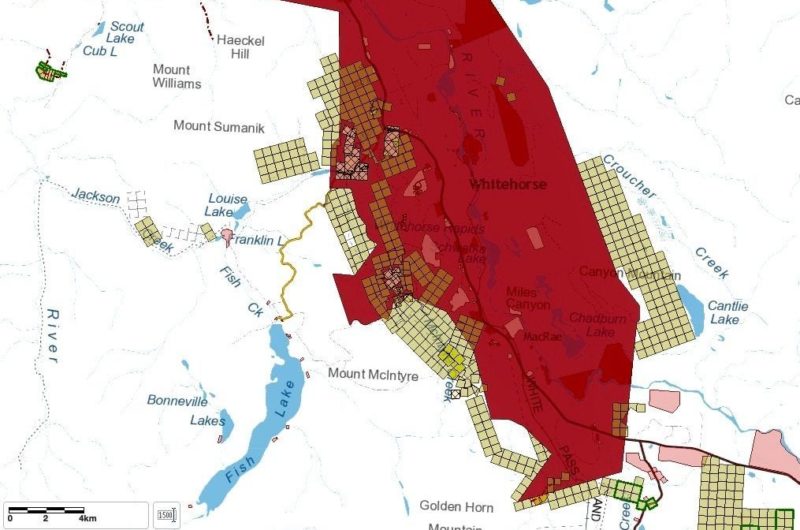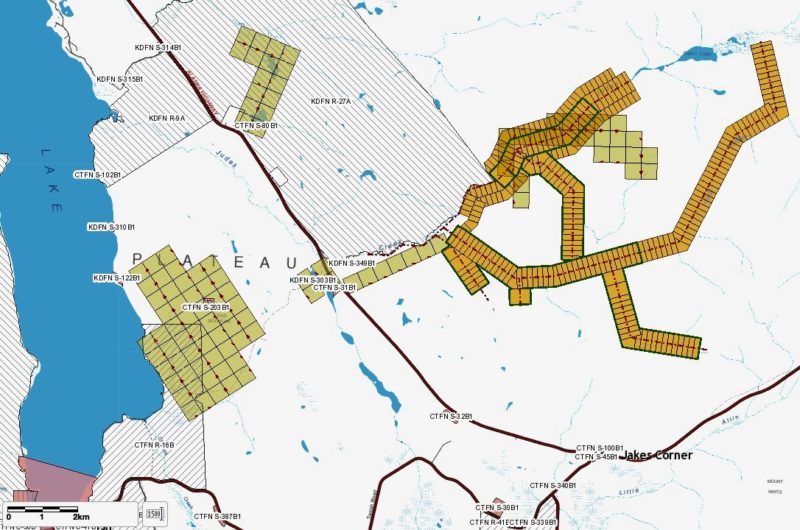
‘Afraid of the water’? Life in a city that dumps billions of litres of raw sewage into lakes and rivers
10 billion litres of sewage are dumped into Winnipeg’s lakes and rivers each year. Some...
Skeeter Wright has owned his densely wooded property in Whitehorse since the 1970s but, for the past two decades, he’s had to share it, in a sense, after a local company staked a piece of his land for mineral exploration.
It came as a surprise to Wright, who only learned about the claim from a neighbour at a community gathering some years ago.
The claim is still active and the company could choose to explore it one day — including the land outside his front window.
While it may sound like a strange scenario, it’s completely legal — a vestige of mining laws created more than a century ago, during the Klondike Gold Rush. There have been amendments but the principle of the so-called “free entry system” has remained the same: after a person drives a few stakes into the ground to plot out an area, the rights to any minerals beneath it are theirs.
“They don’t even ask the Yukon government if they can stake it,” Wright said. “There’s de facto permission because the government did not withdraw the area from staking.”

Skeeter Wright outside his home in Whitehorse. Photo: Julien Gignac / The Narwhal
Wright’s property, south of downtown, just off the Alaska Highway, was staked by local business Kluane Drilling Limited in 2002, according to a Yukon government database. The stake is for a quartz claim, meaning hard rock found underground (placer claims —for loose minerals closer to the surface — aren’t allowed in Whitehorse). The company did not respond to a request for comment.
It’s likely copper the company is after, says Sue Thomas, a spokesperson with Energy, Mines and Resources, in an email to The Narwhal, noting the claim falls within the Whitehorse copper belt. “However, there might also be some gold,” she said.
Wright, who is not Indigenous, formerly worked for the Yukon government on land claims agreements. Now he’s a consultant for First Nations on similar issues. He was contracted by Carcross/Tagish First Nation earlier this year to help write its submission to the Yukon Mineral Development Strategy — a panel tasked with suggesting improvements to Yukon’s mining legislation.
In its submission, Carcross/Tagish First Nation calls on the Yukon government to abolish the free entry system altogether. The nation, like Wright, is concerned with how the free entry system opens access to lands despite conflicting interests. The First Nation did not respond to a request for comment.
Carcross/Tagish First Nation has 1,553 square kilometres of settlement land, stemming from its land claims agreement with the territorial and federal governments. These lands, like those of all Yukon First Nations with settled land claims, are broken down into Category A and B lands. The former means the First Nation has rights to what’s on the surface and beneath it — Carcross/Tagish has just over 500 square kilometres of these lands. The remainder of its settlement lands are Category B, where only surface rights are established — meaning a prospector could stake a claim, despite the nation’s settlement.
Wright argues there should be a requirement for surface rights holders to grant permission before a claim is staked on their land. This, he says, would prevent a Wild West approach of staking claims with abandon.
“Obviously in my case, I would have said no,” Wright says. “The surface belongs to me.”
Anyone 18 years or older, regardless of Yukon or Canadian residency, can lay claim to minerals in Yukon, so long as the claim is located outside territorial parks, certain settlement or municipal lands (some are allowed), and doesn’t overlap with an existing claim.
While stakes can’t be set on private property, the claim they represent can overlap with private property, confirmed Thomas — as in Wright’s case. No stakes were visible from his yard on July 28, but the Yukon government’s online database confirmed the claim.
There are some checks and balances when it comes to staking quartz claims. A prospector can’t build a permanent structure on the land and the claim’s use is for exploration purposes, according to Yukon government guidelines.
Financial security, to cover any damage that may result from exploration of the claim, may be required if a claim has been staked on lands where the surface is owned — think Wright’s property, but also First Nations Category B lands.
After choosing their location, the prospector places a series of stakes apart from each other and clears a line of brush between them, roughly indicating a new claim (according to the Yukon government’s guidelines, an average quartz claim measures 457 metres by 457 metres). Then, a prospector records their claim by filling out an application form to log it with the mining recorder’s office, which is part of the Yukon government’s Department of Energy, Mines and Resources.
“Sketches,” or information that details geological formations and claim boundaries, among other things, is also required by the office. The prospector then pays $10 per claim, and waits out a 30-day period while the office ensures there are no competing claims.

The City of Whitehorse, where placer mine staking is not allowed — the yellow squares represent quartz claims. Map: Government of Yukon

Outside Tagish, Yukon, areas covered in horizontal lines represent settlement land under Kwanlin Dün and Carcross/Tagish First Nation. The yellow squares represent quartz claims and orange boxes represent placer claims. Map: Government of Yukon
If the claim is approved, it expires after one year from the date it was first recorded. If the claim-holder wants to renew, they have to do $100 worth of work within that first year or pay $100, the guidelines say. (This rule was waved in 2020 “due to travel restrictions and economic impacts related to the COVID-19 pandemic.”)
The claim-holder has to pay the $100 or put in the equivalent work every year to maintain their tenure on subsurface rights to that plot, and there is no limit on how many times a claim can be renewed. By comparison, the average property tax for a single detached home in Whitehorse this year is $2,528 — no subsurface rights included.
Any work that’s done on a claim — say, water diversion or building mining infrastructure such as roads or ore extraction facilities — requires First Nations consultation through the Yukon Environmental and Socio-economic Assessment Board process. Landowners, like Wright, are also able to submit comments.
Theoretically, copper could eventually be mined on an industrial scale in the claim that overlaps Wright’s property, but that would require a licence from the assessment board. And because this area falls within the city limits of Whitehorse, anyone hoping to develop a mine would require a permit from city council, as well.
In Carcross/Tagish First Nation’s submission to the Yukon Mineral Development Strategy, the nation urges the territorial government to change the system so staking claims is part of the regular permitting process — requiring consultation. This, the First Nation argues, would give it more say in accepting or denying future claims.
The First Nation says the whole system is “a byproduct of a colonial perspective of northern Canada as an area of no other potential use or interests.”
Carcross/Tagish says a prospector’s stake is the first step toward potentially severe environmental impacts due to exploration or mine development. For that reason, the nation argues an assessment of claims is needed.
“The assessment need not include extremely detailed exploration or mine development plans but should include the consideration of adverse effects of potential major development activities, access and ground disturbance in the area,” it says.
As well as settlement lands, the First Nation wants its traditional territory protected. The nation has 11,500 square kilometres of these lands that it’s used for generations, though they don’t fall under modern treaties. Bringing the claims process under a permitting system would mean the Yukon government has a duty to consult First Nations when a miner eyes traditional territory for minerals.
“Yukon’s current mineral legislation and management regime places short-sighted economic gain above the land-use practices that have supported Indigenous Peoples for generations,” according to Carcross/Tagish.
Ken Coates, a historian at the University of Saskatchewan, says the origins of the free entry system stem from the concept that British colonies were set up on “undeveloped land.”
“It was available for anybody who wanted it, what they used to call in Australia terra nullius, unoccupied land,” he says. “First come, first served was sort of the order of the day.”
“It ultimately created the stampede mentality that resulted in the Gold Rush,” Coates says, noting that it also spurred similar rushes in California and Alaska.
However, those lands that settlers saw as “undeveloped” had often been occupied by Indigenous Peoples for millenia. In Yukon, First Nations traditional territory covers the vast majority of the land. In these areas, First Nations rights, such as the right to hunt, still apply.
Why is B.C. home to more mining exploration companies than anywhere else on earth?
Like Yukon, the free entry system is also in place in B.C. and, similarly, staking can occur virtually anywhere in the province including on First Nations’ land and private property. In a bid to show the lack of restrictions in the system, in 2017 First Nations lawyer Bev Sellars staked a claim on the property of Bill Bennett, then minister of energy and mines.
Other provinces, like Ontario and Quebec, have reformed their free entry systems and increased limitations on what areas can be staked.
In the Northwest Territories, staking a claim requires obtaining the consent of surface rights owners. Carcross/Tagish First Nation argues in its submission that a similar system should be adopted in Yukon.
Mining is inseparable from much of Yukon’s identity as a Canadian territory, Coates says. This could cause problems, if and when changes do occur.
“Quite frankly, when somebody comes up and says, ‘Hey we don’t like that system,’ all those people who work within it, made money through it, spent money through it … took the gambles and took the risks, they’re gonna be very strongly opposed to a change,” Coates says. “In many ways, this is as dramatic a threat to the status quo as the land claims were in the first place.”
The Umbrella Final Agreement, signed in 1993 by Yukon First Nations and the Yukon and Canadian governments, sets a framework for First Nations interested in settling land claims and lays out a roadmap for land-use planning. Eleven of 14 Yukon First Nations have settled their land claims and are self-governing — meaning they can create and enact laws, for example, and have far more jurisdiction than First Nations in southern Canada, most of which fall under the Indian Act.
Coates says the call from Carcross/Tagish to change the free entry system is a “logical outgrowth of the modern treaties.”
According to Carcross/Tagish, “The current system, now acknowledged as antiquated, has resulted in displaced homes, displaced First Nation peoples’ traditional harvesting and severely damaged ecosystems that include fish and wildlife resources.”
While colonial influences are still present today, the nation says modern thinking and court cases that have highlighted a more progressive position on land rights would suggest it’s time to move away from such an unrestrained system for staking claims.
The Yukon government is caught in the crossfire between the mining industry and First Nations, Coates says, adding that the situation needs equal input from all sides.
“There’s been a lot of changes in the sector, and I think the main issue, from my point of view, is can we get to a balance, where we know what the rules are with some level of certainty, that Indigenous communities have an appropriate recognition of their rights and their title and their treaty rights, proper environmental regulations and you don’t stifle the industry.”
Update July 31, 2020 10:25 a.m. PST: This article was updated to reflect that Ontario and Quebec have reformed their free entry systems for claim staking, but have not repealed them, as previously stated.
Get the inside scoop on The Narwhal’s environment and climate reporting by signing up for our free newsletter. On a warm September evening nearly 15...
Continue reading
10 billion litres of sewage are dumped into Winnipeg’s lakes and rivers each year. Some...

Court sides with Xatśūll First Nation, temporarily halting Mount Polley mine waste expansion

Break out the champagne: Emma’s storied life and leadership in journalism has earned her the...
